July 13th Scots Book of Days
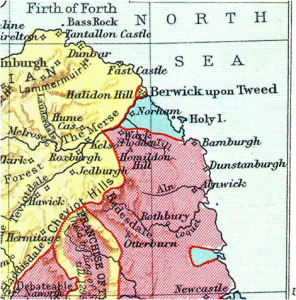 July 13 1174 King William the Lion of Scotland, was surprised and captured by the English at Alnwick, by troops loyal to Henry 2nd of England. Revolt of 1173–1174. Henry’s mother Empress Matilda was granddaughter of William the Conqueror on her father’s side, and granddaughter of Malcolm 3rd King of Scots, and Saint Margaret of Scotland, daughter of Agatha and Edward the Exile (also known as Edward Aetheling, was of the House of Essex during the Saxon period from Alfred the Great, and Egbert before that.) As William was a great grandson of Malcolm 3rd, Kings William and Henry were 2nd cousins on their Scots lines. They were also connected closely on the Warren line. All in the family, after all it was the same Island.
July 13 1174 King William the Lion of Scotland, was surprised and captured by the English at Alnwick, by troops loyal to Henry 2nd of England. Revolt of 1173–1174. Henry’s mother Empress Matilda was granddaughter of William the Conqueror on her father’s side, and granddaughter of Malcolm 3rd King of Scots, and Saint Margaret of Scotland, daughter of Agatha and Edward the Exile (also known as Edward Aetheling, was of the House of Essex during the Saxon period from Alfred the Great, and Egbert before that.) As William was a great grandson of Malcolm 3rd, Kings William and Henry were 2nd cousins on their Scots lines. They were also connected closely on the Warren line. All in the family, after all it was the same Island.
Map of the 1402 Scottish borders area, yellow for Scots, Blue for the Franchise of the Bishopric of Durham, and Pink for English (Northumberland). Alnwick is on the river Aln which flows east into the North Sea 40 miles south of Berwick upon Tweed, about equal distance between Newcastle and Berwick, two days march in either direction. This shows the relation to Newcastle, Otterburn, Radesdale, Rothbury, River Coquet, Battle sites of Homildon Hill and Flodden and Haldion Hill, The Cheviot Hills, Teviotdale, Hawick, Jedburgh, Roxburgh, Kelso, Melrose, Hume Cstle, the Merse river, Norham, Dunbar, Lammermuir Hills, Lauderdale, Edinburgh, and Fast Castle.
On 8 July 1174, Henry II, who had been in Normandy fighting Henry’s enemies, returned to England. His first act was to do penance for the death of Saint Thomas Becket, who, murdered by some of Henry’s knights three years earlier, had already been canonized as a saint. The day following the ceremony at Canterbury, on 13 July 1174, in a seeming act of divine providence for Henry II, William the Lion and many of his supporters were surprised and captured at the Battle of Alnwick by a small band of loyalists. At Alnwick the English found William’s encampment, where the Scottish king was only protected by a bodyguard of perhaps sixty fighting men. At the sound of alarm, William rushed from his tent and hurriedly prepared to fight. The English force charged and the Scottish king and his bodyguard met the charge head on. The fighting did not last long. William’s horse was killed beneath him and he was captured. Those of his followers who survived, surrendered. In the aftermath Henry II was able to sweep up the opposition, marching through each rebel stronghold to receive their surrenders. To obtain his freedom, William was forced to sign the Treaty of Falaise, under which William swore an oath of allegiance to the English king Henry 2nd and agreed to the garrisoning of the captured castles by English soldiers at Scottish expense. When William was released, after signing the treaty, William travelled back to Scotland via Newcastle, and was attacked by a Scottish mob.
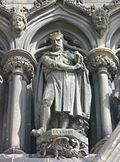 1249 King Alexander III crowned at Scone. Statue of Alexander on the west door of St. Giles, Edinburgh. Crowned at the age of eight, Alexander ruled Scotland for 35 years. His reign became known as “The Golden Age”. www.bbc.co.uk/scotland/history/onthisday/july/13
1249 King Alexander III crowned at Scone. Statue of Alexander on the west door of St. Giles, Edinburgh. Crowned at the age of eight, Alexander ruled Scotland for 35 years. His reign became known as “The Golden Age”. www.bbc.co.uk/scotland/history/onthisday/july/13
1354 Treaty at Newcastle between David Bruce 2nd king of Scots, and Edward 3rd. Ratified but not implemented. France sent soldiers and money into Scotland to continue the waron England. David’s ransom unpaid, he returned to the Tower of London until 1357. Childless, David proposed to parliament in 1363 to crown Lionel Duke of Clarence, second son of Edward the Third as King. Parliament rejected and nephew Robert the Stewart, regent, maintained succession to thecrown. Anderson’s Scots History v.2/p.25-27.
1469 James III married Margaret of Scotland Holyrood Abbey.
1548 James Ogilvy, 5th Lord Ogilvy of Airlie – Lord Ogilvy, One of 24 Lords of the Congregation. James succeeded to the title [S., 1491] before 13 July 1548. James Ogilvy, was born circa 1541. Ogilvy was the son of James Ogilvy, Master of Ogilvy and Katherine Campbell. Ogilvy married Jean Forbes, daughter of William Forbes, 7th Lord Forbes and Elizabeth Keith. Ogilvy died in October 1606 at Farnell, Angus, Scotland. Ogilvy’s will was probated on 20 March 1607, ordering Ogilvy’s burial “in the Isle of the Kirk of Kynnell”. The son of James Ogilvy, master of Ogilvy, who was killed at the Battle of Pinkie in 1547, took a leading part in Scottish politics during the reigns of Mary, Queen of Scots, and of James VI. In June 1562, the 5th Lord Ogilvy was badly injured in a duel with John Gordon of Findlater in Edinburgh. John Gordon was imprisoned until Ogilvy recovered.
On 17 December 1549 James Ogilvy granted an annuity to his uncle, Thomas Ogilvy, out of the lands of Airlie. On 10 May 1560 James was one of the Commissioners who ratified the treaty of Berwick. On 8 May 1568 he signed the association in Queen Mary’s defense, after she escaped from Lochleven. He was then imprisoned until King James VI took the government on himself. In 1596 he was sent as an Envoy to Denmark to assist at the coronation of King Christian IV. His last will was dated 21 July 1606.
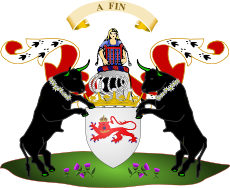 arms of the Earl of Airlie, the chief of Clan Ogilvy.
arms of the Earl of Airlie, the chief of Clan Ogilvy.
Farnell is a village in Angus, Scotland. It lies 2 miles south of the River South Esk, between Brechin and Montrose, near Kinnaird Castle.
1558 Battle of Gravelines (1558). near Calais, France, occurred during the 1547–1559 war between France and Spain. The battle resulted in a victory by the Spanish forces, led by Lamoral, Count of Egmont over the French under Marshal Paul de Thermes. The Spanish were supported by the English Navy, who opened fire on the French as they reached the sand dunes at Gravelines.
1643 Battle of Roundway Down fought near Devizes.
1669 sometime in July. – the Indulgence. Violence in Scotland noticed by English court, government changed, and affording some relief to the oppressed Presbyterians, to try at least the experiment of lenity towards them. ejected clergy as had not give any particular offence, were permitted to preach in vacant parishes, and even received some pecuniary encouragement from Government. Too late. mass of discontented Presbyterians regarded accession to the measure as a dishonourable accommodation with a government by whom they had been oppressed. (TG50-209)
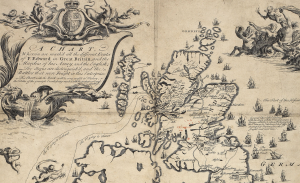 1746 July 13 IN ARISAIG The Prince removed four miles to the eastward of MacDonald of Borradale. (I. 334) to MacLeod’s Cove. t upon a high precipice in the woods of Borradale’ (III. 377). Though the tradition of MacLeod’s Cove is still preserved in the district, its site is entirely lost [G.]. Even in 1746 it was known to very few of the country people’ (I. 334). Cf. III. 191. Publications OF THE SCOTISH HISTORY SOCIETY VOLUME XXIII, Pg 72 (57) April 1897 SUPPLEMENT LYON IN MOURNING PRINCE CHARLES EDWARD STUART ITINERARY AND MAP. Ed.W. B. BLAIKIE, from Narrative of Lord MacLeod, son of the Earl of Cromarty. Chart
1746 July 13 IN ARISAIG The Prince removed four miles to the eastward of MacDonald of Borradale. (I. 334) to MacLeod’s Cove. t upon a high precipice in the woods of Borradale’ (III. 377). Though the tradition of MacLeod’s Cove is still preserved in the district, its site is entirely lost [G.]. Even in 1746 it was known to very few of the country people’ (I. 334). Cf. III. 191. Publications OF THE SCOTISH HISTORY SOCIETY VOLUME XXIII, Pg 72 (57) April 1897 SUPPLEMENT LYON IN MOURNING PRINCE CHARLES EDWARD STUART ITINERARY AND MAP. Ed.W. B. BLAIKIE, from Narrative of Lord MacLeod, son of the Earl of Cromarty. Chart
 1694 The Darien Colony sometime in July. William Paterson, a man of comprehensive views and great sagacity, was the parent and inventor of this memorable scheme. In youth he had been an adventurer in the West Indies, and it was said a bucanier, that is, one of a species of adventurers nearly allied to pirates, who, consisting of different nations, and divided into various bands, made war on the Spanish commerce and settlements in the South Seas, and among the West Indian islands. In this roving course of life, Paterson had made himself intimately acquainted with the geography of South America, the produce of the country, the nature of its commerce, and the manner in which the Spaniards governed that extensive region. Ships at the Port of Leith, near Edinburgh, 1698. www.rbs.com
1694 The Darien Colony sometime in July. William Paterson, a man of comprehensive views and great sagacity, was the parent and inventor of this memorable scheme. In youth he had been an adventurer in the West Indies, and it was said a bucanier, that is, one of a species of adventurers nearly allied to pirates, who, consisting of different nations, and divided into various bands, made war on the Spanish commerce and settlements in the South Seas, and among the West Indian islands. In this roving course of life, Paterson had made himself intimately acquainted with the geography of South America, the produce of the country, the nature of its commerce, and the manner in which the Spaniards governed that extensive region. Ships at the Port of Leith, near Edinburgh, 1698. www.rbs.com
1801 Naval battle. Sir james Saumarez attacks fleet of French. Tytler’s Britannica 263.
1820 Stirling, trial on High Treason of the Radicals captured at the Battle of Bonnymuir. www.bbc.co.uk/scotland/history/onthisday/july/13
1830 Joseph Smith the Prophet, at Harmony, Pennsylvania,. (clan Mack of Inverness, Malcolm King of Scots), Doctrine and Covenants 26. Some days in July. Let your time be devoted to the studying of the scriptures.
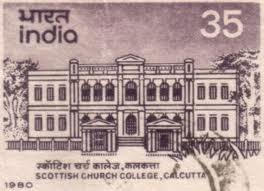 1830 – The General Assembly’s Institution, now the Scottish Church College, one of the pioneering institutions that ushered the Bengal Renaissance, is founded by Alexander Duff and Raja Ram Mohan Roy, in Calcutta, India. Scottish Church College, Calcutta, Indio 1980. www.kamat.org
1830 – The General Assembly’s Institution, now the Scottish Church College, one of the pioneering institutions that ushered the Bengal Renaissance, is founded by Alexander Duff and Raja Ram Mohan Roy, in Calcutta, India. Scottish Church College, Calcutta, Indio 1980. www.kamat.org
1839 Elder John Nicholson born in Boswells, Roxburgshire, Scotland, July 13, 1839. His parents were John Nicholson and Elizabeth Howison. Composed Come, Follow Me, Hymn 116. While of these Emblems we Partake 174, 173. His family moved to Kelso on the Tweed when John was about six years old, and, when he was ten, to Edinburgh. The boy’s meager education was in a tobacco factory, where he got thirty-six pennies a week (plus room and board we suppose). At thirteen, he became an apprentice to a painter and paper hanger. Having read Orson Pratt’s tract on the “Necessity of Miracles” and heard an Elder preach, he joined the Church of Jesus Christ of Latter-Day Saints in 1861. As a Deacon he was branch clerk in Edinburgh, and then ordained a Priest. Two years later, he was Elder Nicholson and given a mission in England, which required his entire time. A great sacrifice both to him and to his parents, he accepted the call and in three days was in his field or labor in the Sheffield conference. In 1866 he came to Utah, married twice and had fifteen children. In 1878 he went on a mission back to England, to act as editor of the “Star,” preaching throughout Great Britain. The anti-polygamy crusade of the Eighteen eighties saw him arrested, tried on evidence furnished by himself, and incarcerated for his convictions. Both before and after this he worked in the editorial rooms of the “Deseret News.” At the completion of the Salt Lake Temple he became chief recorder, which position he held almost to the end. He died January 25, 1909. (Source: The Utah Genealogical and Historical Magazine, January 1910. Transcribed by Maggie Coleman)
genealogytrails.com/utah/saltlake/bios_n.html
2001 Rachel Christena Hardy born. Many great grand daughter of William the Lion. Middle name from her mother’s 2nd great aunt. (clans Cochrane, Stewart, Hunter, Meldrum, Lockhart, Ralston, Rainbolt, Montgomery)
Disclaimer: The author of each article published on this web site owns his or her own words. The opinions, beliefs and viewpoints expressed by the various authors and forum participants on this site do not necessarily reflect the opinions, beliefs and viewpoints of Utah Standard News or official policies of the USN and may actually reflect positions that USN actively opposes. No claim in public domain or fair use. © John Choate
Utah Standard News depends on the support of readers like you.
Good Journalism requires time, expertise, passion and money. We know you appreciate the coverage here. Please help us to continue as an alternative news website by becoming a subscriber or making a donation. To learn more about our subscription options or make a donation, click here.
To Advertise on UtahStandardNews.com, please contact us at: ed@utahstandardnews.com.


Comments - No Responses to “July 13th Scots Book of Days”
Sure is empty down here...